Justice Social Work Statistics in Scotland: 2023-24 – Part 2
An annual bulletin summarising the main trends in community orders and justice social work reports.
5 Community payback orders (CPOs)
(Tables 1 & 5 to 14 and Charts 2-7)
5.1 Orders imposed
(Table 5)
Key statistics for 2023-24:
- Around 15,100 CPOs were issued in 2023-24. This was three per cent higher than in 2022-23 but still lower than the years immediately prior to the Covid-19 pandemic.
- Eighty-six per cent of CPOs imposed in 2023-24 were issued to males.
- Where ethnicity was recorded, 95 per cent of CPOs were for people who classified themselves as white.
- Where employment status was known, 70 per cent of those receiving CPOs were either unemployed or economically inactive. A further 28 per cent were in employment or self-employed.
CPOs are court orders which are imposed on individuals sentenced in relation to offences committed from 1st February 2011. Where a person is convicted of an offence punishable by imprisonment, the court may, instead of imposing a sentence of imprisonment, impose a CPO. The number of CPOs issued in 2023-24 was 15,100, up three per cent on 2022-23 but still lower than any of the pre-pandemic years (Chart 2).
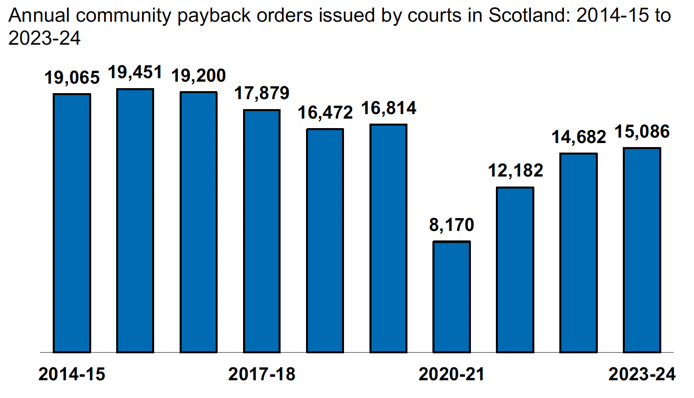
There was a rise in the number of CPOs in the initial years following their introduction on 1st February 2011. Numbers reached a peak of 19,500 in 2015-16. The total CPOs imposed then fell in the next three years to 16,500 in 2018-19, before a small rise to 16,800 in 2019-20. The COVID-19 pandemic and the resulting decrease in court business meant numbers fell sharply in 2020-21, to 8,200. Numbers recovered in each of the next three years, reaching 15,100 in 2023-24, still below the level prior to the pandemic.
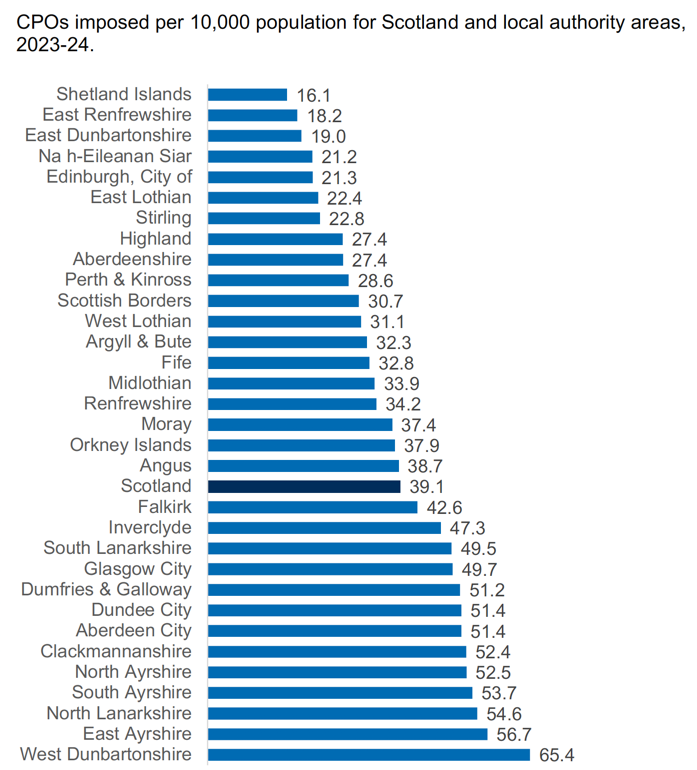
Note: Population estimates used for this graph are the mid-2023 estimates for the age range 16 to 70.
As expected with the rise in CPOs issued nationally, the number imposed per 10,000 population rose from 38 in 2022-23 to 39 in 2023-24 (Chart 3). Nineteen of the 32 Scottish local authorities saw a rise over this period.
In 2023-24, the highest number of CPOs imposed per 10,000 population was for those living in West Dunbartonshire (65), East Ayrshire (57) and North Lanarkshire (55). The lowest population rates were for those living in Shetland Islands (16), East Renfrewshire (18) and East Dunbartonshire (19). While the rate for City of Edinburgh was much lower than for Scotland as a whole, the city council areas of Aberdeen (51), Dundee (51) and Glasgow (50) were each higher than the national average. More detailed information by local authority area is in the additional datasets which accompany this publication.
People aged 26 to 40 accounted for 49 per cent of people getting a CPO in 2023-24. This was much higher than for those aged over 40 (28 per cent). By contrast, in the population as a whole aged 16 to 70 in Scotland, 28 per cent were aged 26 to 40 and 56 per cent were aged over 40.
The average age of people getting a CPO rose every year up to 2021-22, rising from 31.1 years in 2013-14 to 34.6 years in 2021-22. In 2022-23, for the first time, this remained around the same at 34.5 years. It then rose slightly, to 34.7 in 2023-24. In 2023-24, 23 per cent of CPOs were for people aged 25 and under. Those aged over 30 accounted for 61 per cent.
5.2 Requirements
(Tables 6 to 8 and Charts 4-6)
Key statistics for 2023-24:
- A total of 68.0 per cent of CPOs were issued with an unpaid work requirement. Slightly more (68.2 per cent) were issued with a supervision requirement.
- The prevalence increased for eight of the ten CPO requirements between 2022-23 and 2023-24. The changes in prevalence were biggest for restricted movement (up from 1 per cent of orders to 2.1 per cent) and drug treatment requirements (up from 0.8 to 1.4 per cent).
- The average number of hours given as part of unpaid work requirements rose from 127 hours in 2018-19 to 135 hours in 2023-24.
There are ten potential requirements as part of a CPO at first imposition:
- Unpaid work or other activity
- Offender supervision
- Conduct
- Programme
- Alcohol treatment
- Compensation
- Drug treatment
- Mental health treatment
- Residence
- Restricted movement
Every order should have either or both an 'unpaid work or other activity requirement' or an 'offender supervision requirement'. In the publication, these are generally referred to as 'unpaid work requirements' and 'supervision requirements' respectively.
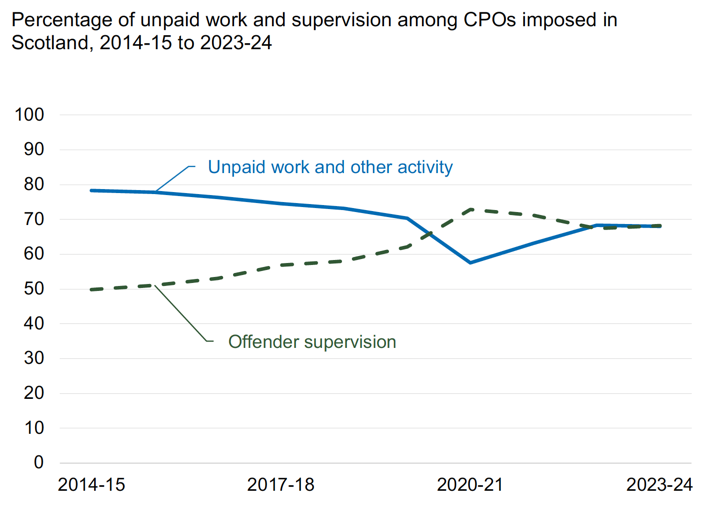
For every year up to 2019-20, unpaid work was the requirement most issued as part of a CPO (Chart 4). The proportion of orders with unpaid work was high in the early years, covering 78 per cent of orders in 2014-15. This then fell slightly in each of the next five years, reaching 70 per cent in 2019-20. It fell sharply to 58 per cent in 2020-21 during Covid, before increasing to 68 per cent in both 2022-23 and 2023-24. It again became the most issued requirement in 2022-23 but, in 2023-24, there were around the same number of unpaid work requirements issued as there were supervision.
The proportion of orders with a supervision requirement rose each year between 2014-15 and 2019-20 reaching 62 per cent (Chart 4). The proportion then rose sharply in 2020-21 to 73 per cent during Covid. It fell in the next two years, reaching 67 per cent in 2022-23, before rising slightly to 68 per cent in 2023-24.
In the years 2014-15 to 2019-20, around 56 to 58 per cent of supervision requirements were for 12 months or less. This fell to around 50 per cent both in 2020-21 and 2021-22 but rose to 53 per cent in 2022-23 and 55 per cent in 2023-24. The average length of supervision requirements across 2014-15 to 2019-20 was around 15.5 months. It was, however, much higher in 2020-21 (16.6 months) and in 2021-22 (16.9 months) during the pandemic, before falling to 16.2 months in 2023-24.
Even though the proportion of CPOs imposed with an unpaid work requirement in 2023-24 was the third lowest in ten years, changes in the length of hours have been occurring. The average number of hours given as part of unpaid work requirements rose from 127 hours in 2018-19 to 135 hours in 2023-24. A major driver behind this increase is that the prevalence of level 2 requirements (i.e. those with more than 100 hours) has increased from 52 per cent of all unpaid work requirements in 2018-19 to 59 per cent in 2023-24.
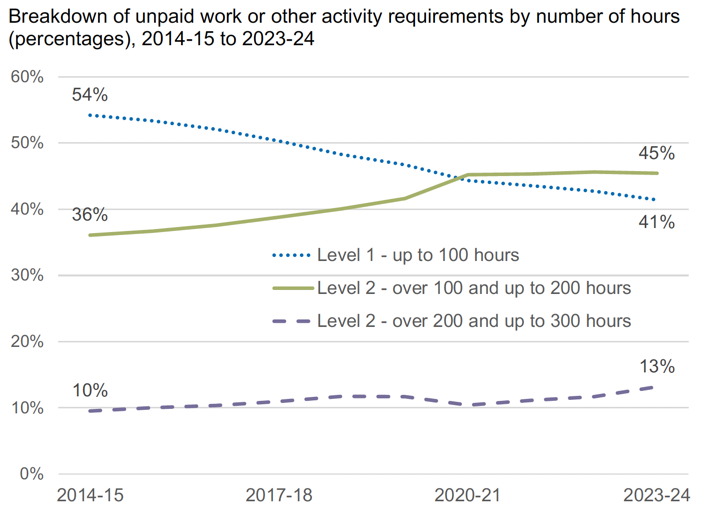
Breakdown of unpaid work or other activity requirements by number of hours (percentages), 2014-15 to 2023-24
Chart 5 gives more detail on how the number of hours imposed has changed for unpaid work requirements over the last decade. In 2014-15, 54 per cent of requirements were issued with up to 100 hours (level 1). By 2023-24, this had reduced to 41 per cent. By contrast, over the same period, there has been an increase in the prevalence of those issued with between 101 to 200 hours, from 36 per cent to 45 per cent. The increase in range for 101 to 200 hours imposed has contributed to the rise in average hours over the decade. The proportion of those with 201 to 300 hours imposed has ranged between 10 and 13 per cent over the last ten years.
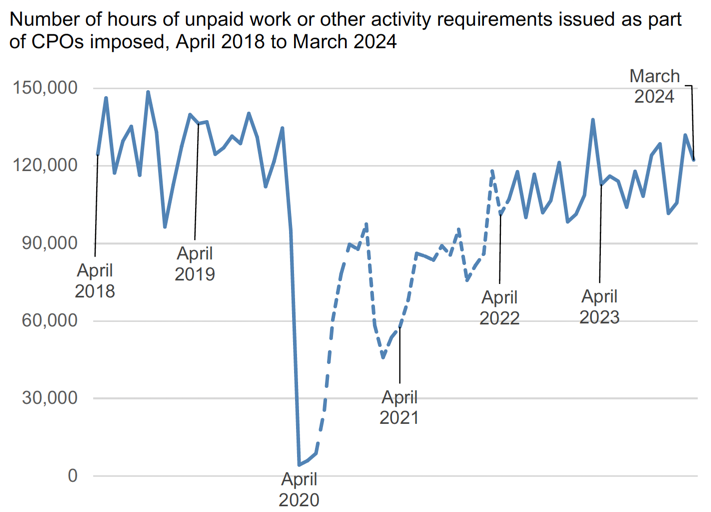
Note: Dashed line indicates the Covid pandemic years 2020-21 to 2021-22.
Chart 6 shows how the total number of hours of unpaid work imposed by courts each month varied across the last six years. With the exception of one month, between 110,000 and 150,000 hours were given out by courts every month between April 2018 and February 2020. After the first COVID-19 lockdown in March 2020, numbers dropped sharply and, although they increased in the rest of 2020, they remained at much lower levels. In early 2021, following the second national lockdown, numbers dropped sharply again, though not as dramatically as with the first lockdown in March 2020. Since February 2021, hours imposed has been on a generally upward trend, averaging around 116,000 per month across year 2023-24.
The type of orders issued in both 2020-21 and 2021-22 was influenced by the impact of the COVID-19 pandemic. Face-to-face delivery of unpaid work had to be suspended for some periods and courts would have been aware of the challenges of delivering unpaid work. Factors relating to the nature of cases which had court hearings during the pandemic, and the circumstances of the individuals involved, may also have been a relevant factor.
After unpaid work and supervision, conduct and programme have been the most issued of the remaining requirements. Apart from a fall in 2022-23, the proportion of orders with conduct requirements has risen each year since 2015-16, up from six per cent in 2015-16 to 14 per cent in 2023-24. The proportion of orders with a programme requirement rose from five per cent in 2015-16 to nine per cent in 2020-21, before falling to seven per cent in 2022-23. This remained at seven per cent in 2023-24. With the exception of mental health treatment requirements, the prevalence for the rest of the requirements rose in 2023-24 compared with 2022-23.
After falling slightly in 2022-23, the average number of requirements per order in 2023-24 rose to 1.65, the highest level in the last ten years.
5.3 Time taken for orders/unpaid work requirements to finish
(Table 14 & Figure 1)
Key statistics for 2023-24:
- On average, 131 hours were done as part of unpaid work requirements successfully completed during 2023-24.
- Around 11.6 million hours of unpaid work or other activity have been carried out since CPOs were introduced.
- It took around nine months on average to successfully complete an unpaid work requirement in 2023-24.
- Since the Covid pandemic, a lower proportion of orders have been finished in the same year as they were imposed.
The number of unpaid work requirements successfully completed fell by 26 per cent between 2014-15 and 2019-20, before decreasing sharply in the first Covid year 2020-21. Numbers rose in each of the last three years, reaching 6,700 in 2023-24. This was still lower than pre-Covid. Since the introduction of CPOs, around 11.6 million hours of unpaid work or other activity have been carried out as part of successful unpaid work requirements.
On average, there were 131 hours carried out for each requirement in 2023-24. This was the highest in the last ten years and four per cent higher than in 2022-23.
It took around nine months (274 days) on average to complete an unpaid work requirement in 2023-24, a reduction of 23 days from 2022-23. The average in 2023-24 was shorter than in the previous three years but longer than in the years 2014-15 to 2019-20, when it was around 212 days.
The longer periods of recent years was expected, particularly over the years 2020-21 to 2022-23, as a result of the Coronavirus (Scotland) Act 2020. Over the period from April 2020 to September 2022, this extended time limits for completion of existing unpaid work requirements in CPOs by 12 months, and required any new requirements made to be given at least 12 months to complete.
Year of imposition |
2016-17 |
2017-18 |
2018-19 |
2019-20 |
2020-21 |
2021-22 |
2022-23 |
2023-24 |
Still being processed |
|---|---|---|---|---|---|---|---|---|---|
2016-17 |
30% |
54% |
14% |
2% |
0% |
0% |
0% |
0% |
0% |
2017-18 |
z |
28% |
55% |
15% |
2% |
0% |
0% |
0% |
0% |
2018-19 |
z |
z |
28% |
55% |
13% |
3% |
1% |
0% |
0% |
2019-20 |
z |
z |
z |
26% |
43% |
25% |
5% |
1% |
1% |
2020-21 |
z |
z |
z |
z |
9% |
58% |
27% |
5% |
2% |
2021-22 |
z |
z |
z |
z |
z |
14% |
56% |
22% |
7% |
2022-23 |
z |
z |
z |
z |
z |
z |
17% |
56% |
27% |
2023-24 |
z |
z |
z |
z |
z |
z |
Z |
19% |
81% |
Notes: z = data for a category that does not apply
Calculated as row percentages. The row headings refer to the year imposed while the column headings refer to the year finished.
Figure 1 illustrates how CPOs are continually being processed by the justice social work system over a period spanning different years. For example, during 2023-24, there were CPOs being processed through the system which were imposed in each of the years 2019-20 to 2023-24. Figure 1 also shows the effect which the Covid pandemic had on how long orders took to finish.
There was a consistent pattern for CPOs imposed in the years 2016-17 to 2018-19 in that generally:
- Just under 30 per cent of CPOs were finished in the same financial year in which they were imposed.
- Around 55 per cent finished in the following year.
- Around 13 to 15 per cent finished in the second year after the imposed year.
The effect of the pandemic and changes in legislation can be seen in the percentage of orders being imposed and finished in the same year. For the last four years this ranged between nine and 19 per cent, while it was between 26 and 30 per cent for the years 2016-17 to 2019-20.
The percentage of CPOs finishing the next year was around 54 to 58 per cent for the years 2016-17 to 2022-23, apart from those imposed in 2019-20 and finishing in 2020-21 which reduced to 43 per cent, during the height of the pandemic. Even though these percentages were quite stable on the whole, the effect of fewer orders finishing in the year of imposition from 2020-21 onwards, has increased the proportion which finished in the second year after imposition. This has ranged between 22 and 27 per cent for orders imposed in the years 2019-20 to 2021-22, compared to 13 to 15 per cent for those imposed in 2016-17 to 2018-19.
For 2023-24, 19 per cent were completed within the year of imposition, the highest since 2019-20. The remaining 81 per cent were still being processed in 2024-25.
5.4 Timescales for implementation
(Tables 9 to 10)
Key statistics for 2023-24:
Where this information was known:
- Sixty-seven per cent of first direct contacts took place within one working day of imposition.
- Seventy-five per cent of first induction/case management meetings took place within five working days.
- Seventy per cent of unpaid work placements started within seven working days.
The Scottish Government community payback order practice guidance supports practitioners and managers in the delivery of CPOs. Further details on the guidance are in Annex B.
Across all CPOs where this information was known, first direct contact took place within one working day of imposition for 67 per cent of orders imposed in 2023-24. This was slightly lower than in 2022-23, and lower than in the years before the pandemic, when it generally fluctuated between 75 to 77 per cent. In addition, in 2023-24, 17 per cent took more than five working days.
In 2023-24, where this information was known, 75 per cent of first induction/case management meetings took place within five working days. This was slightly down on 2022-23 and slightly lower than the levels pre-pandemic. Thirteen per cent took six to ten working days and 12 per cent took more than ten working days in 2023-24.
Where the timescale was known, 70 per cent of unpaid work placements started within seven working days in 2023-24. This was higher than in 2022-23 and was generally around the same level as the years prior to the pandemic
The lower proportions in 2020-21 and 2021-22 for these timescales were likely to have been influenced by the COVID-19 pandemic and related public health measures to keep people safe.
5.5 Orders finished
(Tables 1 & 11 to 13)
Key statistics for 2023-24:
- The successful completion rate for CPOs finished in 2023-24 was 71 per cent, similar to the rates prior to the Covid pandemic.
- Seventy-eight per cent of orders which finished during 2023-24 did not involve any breach applications during the duration of the order.
Orders finished include those that have been successfully completed or discharged early, orders that have been revoked due to review or breach and those finished due to death or other reasons. Those that transfer to other areas are also considered finished in the local authority that the individual has left and are included in the figures for the new local authority they have transferred to.
The successful completion rate for CPOs finished in 2023-24 was 71 per cent. This was lower than the three previous years, returning to levels similar to the pre-pandemic years. The completion rate is calculated by adding together the number of successful completions and early discharges, then dividing this by the total orders finished less orders which were transferred out of a local authority to a different area.
In 2023-24, among orders finished which were not transferred out, 15 per cent were revoked following a breach application to the courts. A further nine per cent were revoked following a review.
Seventy-eight per cent of orders which finished during 2023-24 did not involve any breach applications during the duration of the order. For the remainder, there were a total of 3,700 breach applications made. The vast majority of breach applications (83 per cent) were lodged with the court within five working days of the decision to make an application.
For CPOs revoked due to breach, the most likely outcome from courts (where the outcome was known) was a new CPO at 33 per cent. For a further 29 per cent, it was a custodial sentence. Those where there was no further action for social work accounted a further 19 per cent of orders revoked due to breach. For orders revoked due to review, 20 per cent of those where the outcome was known resulted in a custodial sentence and another 25 per cent got a new CPO or a monetary penalty. The largest proportion, 38 per cent, resulted in no further action for social work. The category "no further action for social work" covers instances where any further action did not have social work involvement and the local authority were not advised of any further penalty e.g. an admonition or where the case was discharged.
5.6 Orders in existence at year end
(Table 1 and Chart 7)
Key statistics for 2023-24:
- The number of CPOs in existence on 31 March 2024 rose to 17,400, the highest level in the last six years.
The number of CPOs in existence increased from 16,600 on 31 March 2023 to 17,400 on 31 March 2024. This was the highest in the last six years and the highest since March 2017.
Chart 7 shows how the numbers in existence changed throughout the last six years. Numbers fell during 2018 then rose slightly between the middle of 2019 and the start of the pandemic. They then went down sharply in the period between March and August 2020, reflecting the closure over this period of many courts. Numbers picked up during the rest of 2020 as more cases were processed by the courts.
The drop shown in March 2021 was greatly influenced by The Community Orders (Coronavirus) (Scotland) Regulations 2021 coming into force. Under these regulations, the specified hours for existing orders with unpaid work or other activity requirements were reduced by 35 per cent (except for requirements imposed for offences involving domestic abuse, sexual offences or stalking). Since May 2021, the number of CPOs in existence has consistently risen, though the level of this rise has been smaller during year 2023-24. This may reflect the fact that the Coronavirus (Scotland) Act 2020, which extended the time limits for the completion of existing unpaid work requirements in CPOs by 12 months, and required that any new requirements imposed during the period in which the legislation was in force had a time limit of at least 12 months, no longer applied after September 2022. Section 5.3 shows that the progression of CPOs has improved since the Covid pandemic but is still below pre-pandemic level. This a factor in the lower number of orders finishing in the last few years, leading to the increase in the number of CPOs in existence over this period.

Note: In order to better illustrate changes over the period covered by this graph, the vertical axis does not begin at number zero.
Contact
Email: justice_analysts@gov.scot
There is a problem
Thanks for your feedback